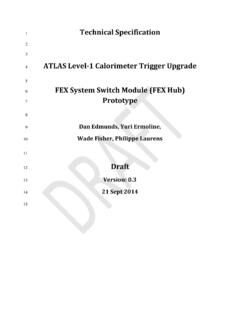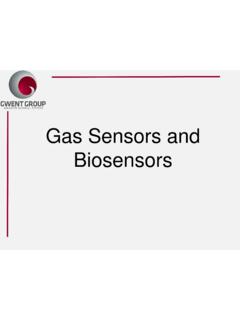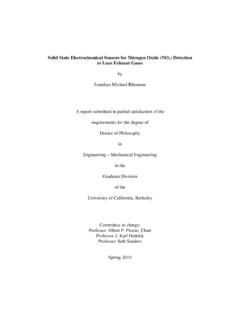Transcription of Fast Solid State Gas Sensor Characterization Technique
1 Fast Solid State Gas Sensor Characterization Technique Ruby N. Ghosh1, Peter Tobias1#, Hui Hu2* and Manooch Koochesfahani2 1 Dept. of Physics and Astronomy, Michigan State University, 2 Dept. of Mechanical Engineering, Michigan State University East Lansing, MI 48824, USA Abstract We describe a new Technique for character-izing fast Solid State planar gas sensors. Using a moving gas outlet, we are able to change the gas around the sen-sor from one component to the next within one millisec-ond in a step-like manner. By simultaneously sampling at 10kHz, 100Hz and 1Hz, we can capture the fast com-ponent of the Sensor response as well as the steady State value in a single experiment. The rate of exchange of the gas around the Sensor was quantified using Laser In-duced Fluorescence (LIF) imaging.
2 The Sensor is char-acterized under standard industrial Sensor operating conditions, including gas pressure and device tempera-ture, while using flows typically found in a research laboratory. Since fast response times from planar gas sensors usually require elevated temperatures, we can heat the device to 630 C. I. INTRODUCTION Gas sensors with fast response times are required for monitoring and also controlling a variety of industrial proc-esses. Examples include feedback control for the mixing of air and fuel in an internal combustion engine and the detec-tion of flame fronts in controlled experiments. Characteriz-ing sensors at the millisecond time scale is difficult in a conventional flow-through cell, as the device responds to a mixture of two gases during the transition from one compo-nent to the next.
3 Thus there is the need for an experimental setup to measure Sensor response times under standard in-dustrial operating conditions, without resorting to extremely high gas flows1 or using vacuum for fast transport of gas analytes to a surface2. II. Experimental A schematic of the fast gas Sensor test set-up with mov-ing gas outlets (MGO) is shown in Fig. 1. It is a relatively open structure, in which the planar Sensor is mounted face down above one of the two MGO outlets. We change the gas environment of the Sensor by rapidly moving the second outlet under the Sensor . This exchange time is kept small by minimizing the gas volume that has to be exchanged. For a planar Sensor (diameter 1mm) the volume is ~ 1 L for a Sensor to outlet separation of 1 mm and using x mm rectangular outlets holes.
4 Our apparatus consists of two halves. The MGO is at-tached to the lower base with the electrical actuator, while the Sensor sample is mounted on the upper portion. The separation, L, between the Sensor active surface and the MGO is set to mm using four precision height pins attached to the upper portion of the setup. Using a set of calibrated shims the separation L can be varied between to mm. During measurements the gas environ-ment around the Sensor is determined by the upward flow-ing gas stream impinging on the active Sensor surface. Typical flow rates are 100 500 ml/min. The open design of our set-up allows us to make Sensor measurements under atmospheric conditions.
5 Having the Sensor mounted on the stationary upper portion of the apparatus also makes it eas-ier to make electrical connections to the device, while ex-changing the gas environment with the MGO. In order to obtain fast response times from a planar gas Sensor with a catalytically active sensing film, the device must usually be heated to accelerate the chemical reactions # Honeywell Laboratory, Minneapolis, MN 55418, USA * Dept. of Aerospace Eng., Iowa State Univ. Ames, IA 50011, USA Fig. 1: Schematic of the fast gas Sensor measurement apparatus. The Sensor is mounted face down. In the "moving part", the two gas jets are separated by a thin barrier, extending mm above the surface.
6 The electrical actuator can rotate the moving part between two stable positions. The actuation translates the gas outlets by 3 mm in 2 ms, thereby switching the gas under the Sensor . 14110-7803-9056-3/05/$ 2005 IEEE. at the catalyst. To this end we mount the Sensor on a ther-mally conducting, but electrically insulating, alumina header. Three Pt micro-heaters are attached with a ther-mally conducting paste to the backside of the alumina header for temperature control up to 630 C and to ensure temperature uniformity over a 1 cm2 Sensor chip. In order to completely characterize the performance of a gas Sensor it is necessary to be able to monitor the Sensor response at all time scales, preferable in a single measure-ment.
7 To this end we have developed a data acquisition system that simultaneously monitors the Sensor output volt-age at 10 kHz for 100 ms, at 100 Hz for 10 s and at 1 Hz for an arbitrary period of time. The zero in time is set with respect to the pulse sent to the actuator of the MGO. In this manner we are able to monitor in a single experiment, both the short and long term response of the Sensor without gen-erating unduly large data files. We characterized the performance of the fast gas Sensor setup using a Pt/SiO2/SiC planar gas Sensor suitable for detection of hydrogen containing Fig. 2 shows a schematic of the Sensor . III. RESULTS Quantitative measurements of the gas exchange rate around the Sensor were obtained from a temporal sequence of laser induced fluorescence images taken in the x-z plane as shown schematically in Fig.
8 3. One of the two gas steams is seeded with acetone, which fluoresces upon UV In the digital image, the gas stream seeded with acetone will be bright while the unseeded gas stream will be dark. The light intensity immediately below the Sensor position as a function of time (t=0 is the beginning of the actuator pulse) was evaluated for a number of differ-ent conditions. Using a gas flow rate 0f 370 ml/min and a Sensor to outlet separation is 1 mm we find that the gas en-vironment of the Sensor is completely exchanged in ms. IV. CONCLUSION We have developed a fast (millisecond) apparatus to characterize planar gas sensors under atmospheric condi- tions, similar to those encountered in standard industrial, applications.
9 Using laser induced fluorescence imaging we characterized the gas flow in the set-up as a function of typical experimental parameters. We find that under opti-mum conditions the gas around a 1 mm diameter planar Sensor can be completely exchanged in 1 ms. Additional Sensor measurements were obtained from a SiC based hy-drogen gas Sensor (Pt-SiO2-SiC) ACKNOWLEDGMENTS The SiC devices were fabricated in the W. M. Keck Mi-crofabrication Facility at Michigan State University. This article was prepared with the support of the U. S. Depart-ments of Energy, under Award However, any opinions, findings, conclusions, or recom-mendations expressed herein are those of the authors and do not necessarily reflect the view of the DOE.
10 Fig. 3: Schematic of the laser induced fluorescence images of the MGO (a) at rest and (b) in motion. The gas outlets move sideways below the fixed Sensor . The right gas flow is seeded with acetone, the left flow is not. By illuminating the space above the gas outlets with a UV laser pulse the acetone molecules luminesce and appear as bright areas in a photograph, while the gas flow on the left which is unseeded is dark. Quantitative information on the gas exchange rate is obtained by analyzing a series of digital images taken at a fixed time after the beginning of the electrical pulse to the actuator. Fig. 2: Schematic of the SiC Sensor for detection of hydrogen contain-ing gases.



















